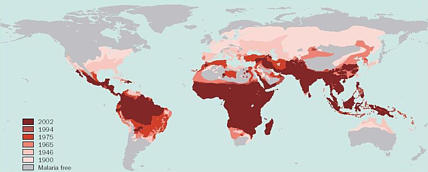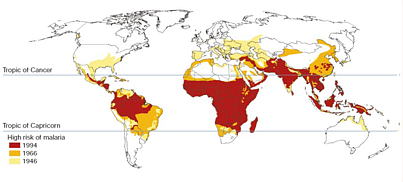Complex of problems
Malaria is one of the most serious health problems in the world (e.g. Savingy and Binka 2004) and is
causing about 273 million clinical cases and 1.12 million deaths annually. More than 40% of the global
population (>2.1 billion people) are exposed to the malaria disease (Touré and Oduola 2004).
In about 100 countries malaria risk of varying degrees exists. For example, in Benin malaria is
generally recognized as a major threat to health (Velema et al. 1991).
The life-threatening disease
is mostly restricted to young children (e.g. Gupta et al. 1999) and is leading to a malaria
specific mortality of about 6 to 11 per 1000 childen below five years per annum (Snow and Marsh 1995).
Thus, malaria is killing every year approximately 500,000 African children (Snow et al. 1999).
At least 90% of the more than 1 million yearly deaths occur in sub-Saharan Africa (Greenwood and Mutabingwa 2002;
Greenwood et al. 2005).
Climate change impact
The climate system of the Earth strongly affects the human life and consequently has a wide
range of health impacts. Humans are mainly changing the earth climate by the emission of greenhouse gases that
leads to anthropogenic global warming (IPCC 2007). It is well known that a warm and humid
climate triggers several waterborne diseases such as malaria, schistosomiasis and yellow fever
(Githeko et al. 2000). These world's most prevalent vector-borne diseases are highly sensitive
to global warming and associated changes in precipitation (Martens et al. 1997).
With high confidence the International Panel on Climate Change (IPCC) states that climate change is expected
to have some mixed effects, such as the decrease or increase of the range and transmission potential of
malaria in Africa (IPCC 2007).
Nonclimatic factors
Likewise nonclimatic factors also serve as drivers of malaria transmission across the African
continent (Small et al. 2003). Increases in East African highland malaria in the 20th century are in addition
attributed to a rise in antimalarial drug resistance, to breakdowns in health service provision
and vector control operations and to land use changes (Shanks et al. 2000). Especially in the
Sahelian and Soudanian zone man-made changes of the landscape are causing changes in the
transmission of malaria. Agriculture is supposed to ameliorate human nutrition, livelihood and
hence survival (van der Hoek 2004). Indeed, the development of irrigation systems has created
favourable conditions for the reestablishment of malaria vector Anopheles funestus in Sahelian
Senegal (Konate et al. 2001). In irrigated zones transmission of malaria becomes fairly constant
over a perennial season, whereas it is variable in neighbouring non-irrigated
areas (Dolo et al. 2004).
The information system MalaRis
However, the climate in Africa has a strong impact upon the distribution of malaria transmission in time
and space. Because climate change is in full progress, information with regard to the future transmission
of malaria will be needed in order to successfully combat this vector-borne disease.
Because of the linkage between climate and malaria the MalaRis system
provides information regarding malaria risk of the African population for the past and the near future.
Assessed are possible changes in the geographical range, the seasonality of malaria (intraannual
variability), and in the disease prevalence (i.e. the proportion of the population that is carrier
of the malaria parasite).
|

|
Fig.. 1: The global distribution of malaria since preintervention from about 1900 to 2002
(Fig. 1 in Hay et al. 2004).
|

|
|
Fig.. 2: Global distribution of malaria. The changing global distribution of malaria risk from 1946 to
1994 shows a disease burden that is increasingly being confined to tropical regions
(Fig. 1 in Sachs and Malaney 2002).
|
